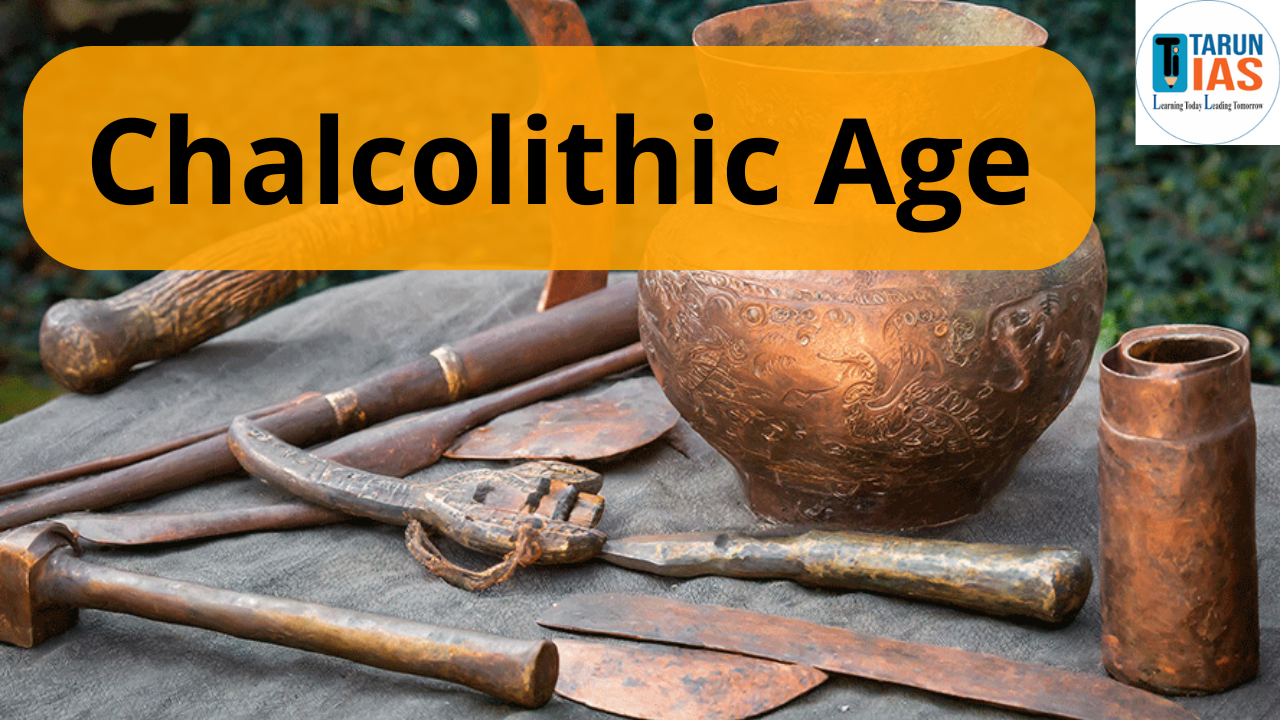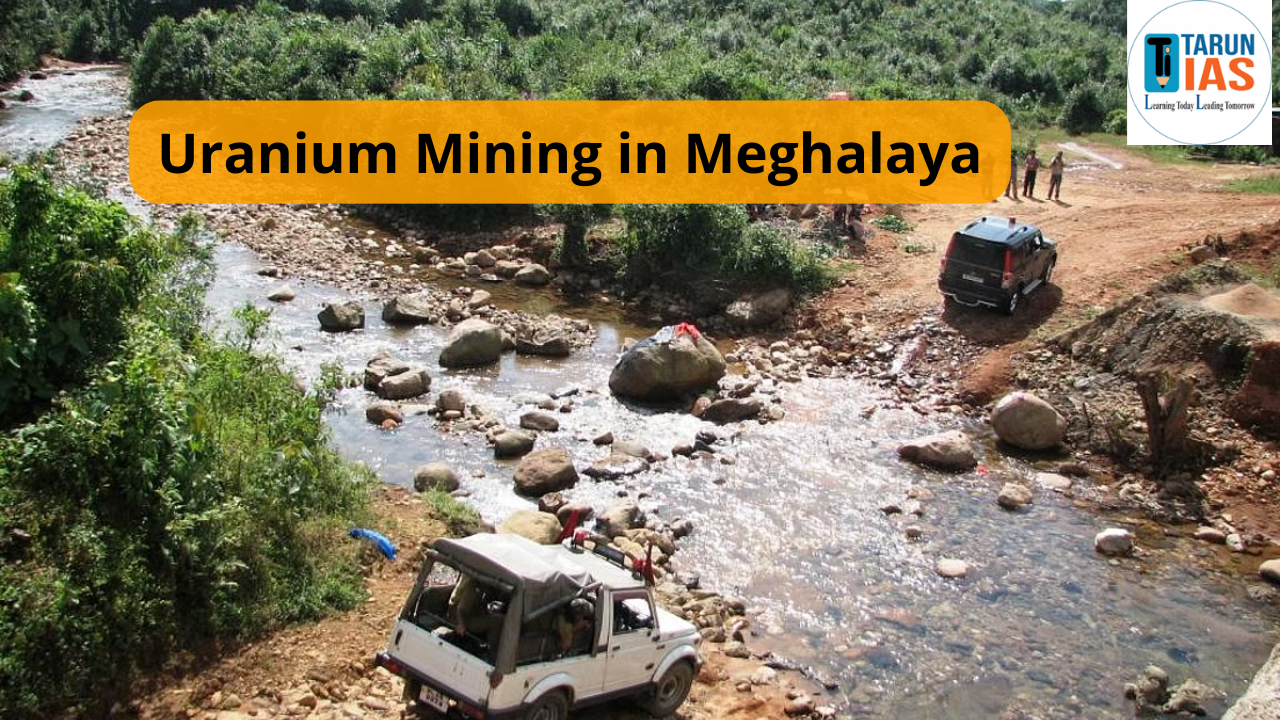Chalcolithic Age (literally the Copper-Stone Age) represents a crucial transition in Indian history. It marks the first time that humans began using copper alongside stone tools, symbolizing early advances in metallurgy and agriculture. This period was neither fully urban like the Harappans nor entirely primitive like the Neolithic, but a blend that laid the foundation for future civilizations. The Chalcolithic age time period was 4000 BC – 2000 BC.

- This era in India unfolded in three broad phases, each carrying unique features:
- Pre-Harappan Phase (c. 3500–2500 BCE) This early stage saw the rise of agrarian communities gradually shifting from hunting to settled farming. People started crafting pottery and began limited use of copper tools.
- Harappan Phase (c. 2500–1750 BCE) Coinciding with the mature Indus Valley Civilization, this period witnessed the coexistence of urban Harappans and non-urban Chalcolithic communities in Central and Western India. These groups maintained distinct identities yet displayed signs of interaction.
- Post-Harappan Phase (c. 1750–1000 BCE) As the Indus cities declined, regional Chalcolithic cultures flourished across Maharashtra, Rajasthan, Madhya Pradesh, and Gujarat. Their identities became sharper, reflected in pottery styles, burial customs, and religious symbols.
Chalcolithic Age Cultures and Social
The Chalcolithic Age marked a vital cultural transition in India, showcasing distinct regional identities, emerging social hierarchies, and evolving belief systems alongside copper use and painted pottery traditions.
- A standout feature of the Chalcolithic Age is its regional diversity. Each community whether Ahar in Rajasthan, Malwa in Madhya Pradesh, or Jorwe in Maharashtra developed unique cultural patterns while sharing core traits like copper usage, painted pottery, and village-based economies.
- Beyond material chalcolithic age tools, this age saw early social hierarchies and spiritual practices. Chiefs lived in larger rectangular homes, while commoners lived in round huts. Fire altars and Mother Goddess figurines point to ritual life and evolving belief systems.
- In essence, the Chalcolithic Age was more than just a technological shift. It was the seedbed of Indian civilization, nurturing regional cultures that would echo across history.
Features of Chalcolithic Age
The Chalcolithic Age featured chalcolithic age tools or copper tools, settled farming, regional pottery styles, permanent villages, and emerging social and ritual practices.

- The Chalcolithic Age, also known as the Copper-Stone Age, marks a significant chapter in Indian prehistory.
- It represents a transitional phase where the use of both stone tools and copper implements shaped early agrarian lifestyles and laid the cultural foundations of future Indian societies.
- Unlike the urban Harappan civilization, Chalcolithic cultures were primarily rural and regionally distinct, yet they displayed advanced socio-economic and cultural traits.
Material Culture and Housing in Chalcolithic Age
The Chalcolithic Age featured handmade pottery, copper tools, and stone implements, while housing ranged from circular huts for commoners to large rectangular dwellings for elites, reflecting social stratification.
- The defining feature of this era was the use of both copper and stone for making chalcolithic age tools. While stone remained important for daily activities, copper was increasingly used for weapons, ornaments, and rituals.
- People built homes using mud, mud-bricks, and rammed earth. Structures were mostly rectangular or circular, often with multiple rooms and thatched roofs.
- The size and complexity of homes also hinted at social stratification within these early communities.
Subsistence and Economy in Chalcolithic Age
The economy of the Chalcolithic Age was based on agriculture, animal husbandry, and limited trade. Communities practiced subsistence farming, used copper tools, and gradually developed small-scale exchange networks for survival.
- The Chalcolithic economy was largely village-based and relied on agriculture, pastoralism, hunting, and fishing. Farming was conducted using wooden or bone ploughs, and evidence suggests the use of primitive irrigation systems.
- During favorable weather, communities relied on cattle grazing, but in harsher conditions, they switched to sheep and goat herding, showcasing their adaptability.
Religion and Rituals of Chalcolithic Age
People in the Chalcolithic Age mainly worshipped nature, mother goddesses, and fertility symbols. They performed rituals with terracotta idols, sacred fire, and burial practices to show belief in life after death.
- Religious practices were deeply symbolic. The cult of the Bull and the Mother Goddess were widely worshipped, pointing to fertility-centric belief systems.
- Archaeological excavations have uncovered fire altars at several chalcolithic age sites, indicating the ritualistic practice of fire worship, possibly including animal sacrifice. These findings highlight the emergence of organized religion and sacred spaces.
Pottery and Artistic Traditions in Chalcolithic Age
Pottery in the Chalcolithic Age was handmade or wheel-made, often painted with simple geometric or floral designs. Art reflected daily life, with terracotta figurines, beads, and chalcolithic age tools showing evolving aesthetic sense.

- Pottery was not just functional but deeply cultural. The Black-on-Red Ware became a hallmark of the Chalcolithic Age. While there was overall uniformity in pottery style, each sub-culture developed distinct motifs and forms.
- The Jorwe culture, for instance, is noted for its matte red pottery painted in black, found mainly in Maharashtra and parts of Madhya Pradesh.
- This aesthetic expression suggests specialized craftsmanship and artistic sensibilities.
Burial Practices and After life Beliefs in Chalcolithic Age
Chalcolithic people believed in life after death, as seen in their burial practices. They buried the dead with food, tools, and pottery, suggesting hope for a continued existence beyond death.

- Chalcolithic age burial sites associated with the Malwa and Jorwe cultures reveal a strong belief in life after death.
- Graves often included funeral pots and utility items, indicating a ritualistic farewell and faith in an afterlife. This reflects the intellectual and spiritual evolution of early Indian communities.
Cultural Exchange and Regional Identity in Chalcolithic Age
During the Chalcolithic Age, regional cultures developed distinct identities through unique pottery styles, chalcolithic age tools, and settlement patterns. At the same time, cultural exchange occurred through trade, migration, and shared rituals.
- Chalcolithic societies were not isolated. The discovery of foreign items and trade goods at several Burial suggests cultural contact and exchange.
- Despite being non-urban, these communities maintained a distinct regional identity, as seen in Ahar, Kayatha, and Jorwe cultures, which developed unique practices while interacting with broader civilizations like the Harappans.
Chronology and Cultural of Chalcolithic Age in India
The Chalcolithic Age in India (3000–700 BCE) marked regional growth with cultures like Ahar, Malwa, and Jorwe, showcasing diverse pottery, tools, and evolving rural life before the Iron Age.
- The Chalcolithic Age (roughly 1800 BCE–1000 BCE), often referred to as the Copper-Stone Age, wasn’t a monolithic era. It evolved over centuries, overlapping with the Harappan civilization and eventually blending into the Early Historic and medieval phases.
- Its significance lies in the rise of regional cultures that were agriculturally advanced, metallurgically aware, and socio-culturally distinct.
Chronological Phases of Chalcolithic Cultural Development
Chalcolithic culture evolved in early, mature, and late phases, reflecting regional growth in farming, metallurgy, and settlement patterns.
- Period I – Chalcolithic (c. 1800 BCE – 700 BCE)
- This was the foundational phase marked by the use of copper tools, handmade pottery, and rural settlement patterns. It was also the age of major regional cultures like Ahar, Malwa, and Kayatha.
- Period II – Early Historic (c. 700 BCE – 1st CE)
- In this phase, Chalcolithic traditions began to merge with early urban centers. The influence of iron, writing systems, and coinage began to take shape. Still, rural cultures retained their traditional pottery and agricultural practices.
- Period III – Early Medieval (1st CE – 6th CE)
- While the core Chalcolithic way of life diminished, remnants of it—especially in pottery traditions—can be traced in folk practices and rural crafts.
- Period IV – Late Medieval (16th – 18th CE)
- Surprisingly, certain technological traits and ceramic designs from the Chalcolithic era continued in remote village societies, testifying to the deep cultural roots of this period.
Chalcolithic Age Regional Cultures and their Features
Chalcolithic regional cultures like Ahar, Malwa, Kayatha evolved uniquely, showcasing local pottery, agriculture, metallurgy, and settlement patterns.
- Ahar Culture (Rajasthan)
- Found in the Banas Valley, including chalcolithic age site like Ahar, Balathal, and Gilund, this culture is known for its black-and-red ware pottery. The Ahar people practiced agriculture and copper smelting and lived in well-organized rectangular houses.
- Kayatha Culture (Madhya Pradesh)
- Located near the Chambal River and its tributaries, Kayatha culture stood out for its red-slipped pottery with chocolate-colored geometric patterns.
- It is one of the earliest known Chalcolithic settlements in Central India.
- Malwa Culture (Western MP & Gujarat)
- One of the most expansive Chalcolithic traditions, Malwa culture developed along the Narmada River and its basin.
- It is noted for its large settlements, planned housing, granaries, and use of buff ware pottery with linear designs.
- Prabhas and Rangpur Cultures (Gujarat)
- Descendants of the Harappan legacy, these cultures reflect a clear continuity of Indus Valley traditions.
- Their hallmark is the use of polished red ceramics and fortified settlements, along with semi-urban planning.
Significance of Chalcolithic Age in India
The Chalcolithic Age, also known as the Copper-Stone Age, marks a critical transitional period in Indian history. It represents the stage between the Neolithic Age and the early Iron Age, defined by the simultaneous use of copper tools and stone implements. This phase witnessed the rise of organized rural settlements, early farming economies, and gradual social differentiation. Its significance lies not merely in the use of copper but in how it laid the cultural groundwork for future civilizations.
Geographical Spread and Settlement Patterns Chalcolithic Age

- The Chalcolithic cultures emerged across a vast part of the Indian subcontinent—excluding the alluvial Gangetic plains and dense forested regions.
- These communities preferred settling near rivers, hills, and fertile lands, especially in parts of Rajasthan, Madhya Pradesh, Maharashtra, Bihar, and West Bengal.
- The availability of water, suitable terrain for agriculture, and mineral resources played a vital role in their site selection.
Technological Innovations and Tools of Chalcolithic Age
- A defining feature of the age was the dual use of stone and copper tools. While stone microliths continued to be used for daily activities, copper was employed for more durable chalcolithic age tools, ornaments, and weapons.
- The people were familiar with smelting techniques, showcasing early metallurgical knowledge. Though bronze was occasionally used, it was of inferior quality due to the limited access to tin.
Pottery and Craftsmanship of Chalcolithic Age
- The Chalcolithic people were pioneers in producing painted pottery. Their pottery style—mostly wheel-made black-and-red ware—was both artistic and utilitarian.
- Vessels like lota (globular drinking pot) and thali (flat plates) were used for daily life, showing early forms of culinary culture. Pottery was used for cooking, storage, rituals, and burials, reflecting the community’s aesthetic sensibility and specialized craft traditions.
Agriculture and Economy of Chalcolithic Age
- This period marks the first widespread agricultural expansion in Peninsular India. The Chalcolithic people cultivated a variety of crops including wheat, barley, lentils, rice, and pulses.
- Chalcolithic age sites like Inamgaon and Kayatha provide archaeological evidence of cereal storage and irrigated farming.
- Alongside agriculture, fishing, animal husbandry, and limited trade supported a stable rural economy. Fish and rice were staple foods in many regions.
Social Structure and Living Conditions of Chalcolithic Age
- Society in the Chalcolithic Age shows signs of early social hierarchy. Wealth and status varied across settlements. For example, archaeological evidence suggests prosperous households in Inamgaon, Kayatha, and Eran, while Chirand and Pandu Rajar Dhibi reflect relatively poorer living standards.
- Housing structures ranged from simple huts to larger, well-constructed homes, often indicating the social rank of their occupants.
Burial Customs and Religious Beliefs of Chalcolithic Age
- Burial practices reveal both regional variations and spiritual beliefs.
- In Maharashtra, the dead were generally buried in a north-south orientation, while in southern India, an east-west alignment was more common.
- The inclusion of pottery, ornaments, and tools in graves suggests a belief in life after death. Religious artifacts such as Mother Goddess figurines and bull icons point to fertility worship and early ritualism. Fire altars at several sites indicate the practice of fire-worship and animal sacrifice.
Cultural Legacy and Historical Importance of Chalcolithic Age
- One of the most important legacies of the Chalcolithic Age is its role in regional cultural formation.
- These societies were the first to organize large-scale rural communities, practice systematic agriculture, and show early socio-political organization.
- The term Neolithic–Chalcolithic is often used to describe this transformative phase, as it represents the evolution from stone-based cultures to those embracing metal and settled economies.
- The Chalcolithic culture, though non-urban, had a far-reaching influence.
- Its sites—like Kalibangan (Pre-Harappan), Bharuch, Jorwe, and Nevasa—bridge the historical gap between the Harappan urban centers and later Iron Age societies.
- Between 2000 BCE and 700 BCE, the cultural core of Chalcolithic India revolved around village-based farming societies, which left a lasting imprint on the subcontinent’s cultural fabric.
Chalcolithic Age vs Bronze Age
In the phases of human development there’s two important stages: the Chalcolithic Age and the Bronze Age. Both are part of the post-Neolithic era, and both show how humans improved their tools, farming, and lifestyle. But still, they are different in many ways.
What is the Chalcolithic Age?
The word Chalcolithic comes from two words – ‘Chalcos’ meaning copper and ‘lithic’ meaning stone. So, the Chalcolithic Age is also called the Copper-Stone Age.
This age marks the time when humans started using copper tools along with stone tools. Copper was softer, so it was not very strong, but it was better than just stone. People were learning metal use, but they were still not experts.
Time Period in India: Around 3000 BCE to 1000 BCE (varies from region to region)
Key Features:
- People used copper tools and stone tools together.
- They settled agriculture and began living in villages.
- Pottery was common – black and red ware, painted designs.
- People domesticated animals like goats, sheep, and cattle.
- No proper writing system was found, but symbols and decorations were used.
- No bronze was used widely during this time.
Chalcolithic Cultures in India:
- Ahar culture (Rajasthan)
- Jorwe culture (Maharashtra)
- Malwa culture (Madhya Pradesh)
- Ochre Coloured Pottery (OCP) culture (UP)
What is the Bronze Age?
After the Chalcolithic period, humans discovered how to make bronze – an alloy made by mixing copper and tin. Bronze is stronger and more durable than copper. This discovery led to the Bronze Age.
The Bronze Age brought urbanisation, advanced tools, and large civilizations like the Indus Valley Civilization in India.
Time Period in India: Around 2600 BCE to 1900 BCE (Harappan Phase)
Key Features:
- People used bronze tools and weapons.
- Large cities like Mohenjo-Daro, Harappa, Dholavira came up.
- Proper town planning with drainage, roads, and granaries.
- Use of weights, measures, and a written script (yet to be fully decoded).
- Trade with other regions like Mesopotamia.
- Skilled in crafts, bead-making, and metallurgy.
- Agriculture was more organised and surplus was stored.
Chalcolithic Age vs Bronze Age – Key Differences
The key difference between the Chalcolithic Age and Bronze Age is that the Chalcolithic Age used simple copper and stone tools with small village life, while the Bronze Age saw stronger bronze tools, urban cities, trade, and early writing systems.
| Aspect | Chalcolithic Age | Bronze Age |
| Metal used | Mainly copper, along with stone tools | Bronze (copper + tin) |
| Tool quality | Weaker tools, limited use | Stronger and sharper tools |
| Settlements | Small villages and farming communities | Big, planned urban cities |
| Writing system | No proper script found | Developed script (Harappan script) |
| Art and pottery | Simple painted pottery | Advanced pottery and crafts |
| Trade and economy | Localised, small-scale trade | Long-distance trade with foreign lands |
| Time in India | 3000 BCE – 1000 BCE | 2600 BCE – 1900 BCE (Harappan period) |
| Examples | Ahar, Jorwe, Malwa cultures | Harappa, Mohenjo-Daro, Dholavira |
Conclusion
The Chalcolithic Age in India was much more than a technological advancement—it was a cultural revolution. With the adoption of copper tools, painted pottery, agriculture, and complex rituals, Chalcolithic communities laid the early foundation of Indian civilization. Their regional identities, economic adaptability, and spiritual beliefs set the stage for the social and cultural complexity that would define India in the centuries to come.















